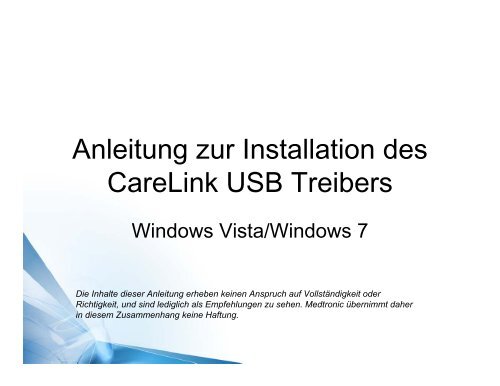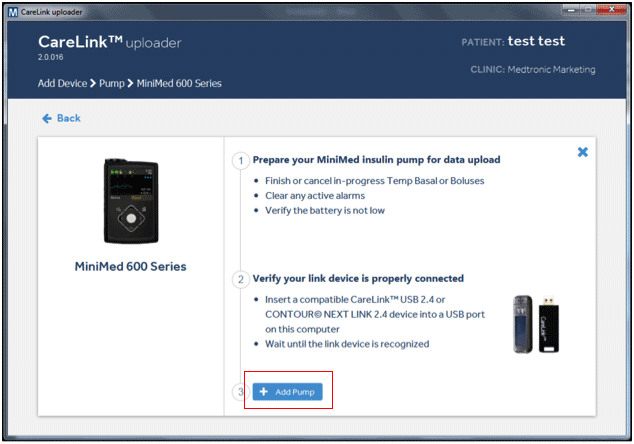

- #Carelink usb stick trial#
- #Carelink usb stick Bluetooth#
- #Carelink usb stick plus#
- #Carelink usb stick mac#
I choose to call my app Skadoosh, complete with a Po app icon
#Carelink usb stick mac#
All I had to do was fork (copy) his Github repository (Github is a social coding website), clone it to my Mac (boop beep), change a few lines of text and Build/Run the iOS app on my iPhone using Xcode (sounds easy, right?). That next logical step is found in the LoopKit framework and Loop app written by Nathan Racklyeft. (RileyLink PCB & Li-Po battery hotness next to giant in comparison Raspberry Pi rig) This also meant I wouldn’t need my Dexcom receiver that I was using with my Raspberry Pi rig, or the huge battery for power. Especially because it allowed me to use my Dexcom G5 transmitter that already communicated with my iPhone via BLE. The next logical step, of course, was for someone to write an iOS framework and app to allow you to use your iPhone to run your artificial pancreas algorithm instead of having to carry around either of the above microcomputer/battery/radio combos seen above.īeing the lover of Apple and iOS devices that I am, this to me seemed like a great option.
#Carelink usb stick Bluetooth#
(Pictured: Intel Edison rig with TI stick in front of MiniMed pump for scale)Įxpanding on that, there are makers like Pete Schwamb who designed a tiny printed circuit board (PCB) that has a Bluetooth Low Energy (BLE) chip that then can communicate with Sub 1GHz devices, which include the Medtronic MiniMed pumps being used for OpenAPS. The doers and makers in the OpenAPS community have built rigs with the Intel Edison, the smaller Raspberry Pi Zero, and replaced the CareLink USB radio stick with a more powerful range found in the Texas Instruments CC1111 (TI Stick). Wanting to reduce the physical size of my rig, I started exploring and learning about the tiny versions people were using including replacing the Raspberry Pi with a much smaller Intel Edison microcomputer.

I spent the first couple weeks using this system just amazed at what a difference it was already making in my therapy. give insulin), my OpenAPS rig adjusts my insulin delivery in coordination with the readings from my CGM. I used to think 50% in range was doing pretty good! Instead of only making decisions when I tell my pump to do something (e.g. As of it is showing an estimated 5.8 A1C, and that is with 74% in range 75-160 mg/dL and only 8% hypoglycemia. 6 points to 6.0 from my last lab tested result of 6.6 from May 2016. I started using this system June 3, 2016, and according to the HbA1c estimate from my Dexcom reports I am down. Here’s what a rig like this looks like.Īll of these electronic bits fit snuggly inside a small digital camera bag.
#Carelink usb stick plus#
I started off building an OpenAPS “rig” that used a Raspberry Pi 3 computer, my Dexcom CGM receiver, a Medtronic CareLink USB stick (for radio communication to my insulin pump) plus a 9000mAh external battery to power the Raspberry Pi. It’s not easy, but with the help of others, anyone motivated enough can do it. Through the community found on Gitter and Twitter we help each other go through the process of making our own DIY artificial pancreas. I have joined the now 100 diabetics (or parents/loved ones of) who have built/assembled their own open source artificial pancreas. Like I said, it is going to (soon) be a great time to be a diabetic. There are even still more, but those are some of my favorites. They hope to be able to offer a bi-hormonal insulin & glucagon system that will not adjust insulin delivery for high and low blood sugar, but infuse glucagon, which would raise blood sugar back to a safe level. And then there is my personal favorite (mostly because of the name) from Boston University based Beta Bionics and their iLet “fully integrated bionic pancreas”. The Bigfoot system will use an iPhone connected to their pump device, in addition to using a Dexcom G5 for CGM.

#Carelink usb stick trial#
Bigfoot Biomedical has announced the beginning of a closed loop clinical trial ( Closed Loop?). Medtronic has filed for Pre-Market Approval for their MiniMed 670g with the expectation of receiving a decision from the FDA in a year. Insulin Pump and Continuos Glucose Monitor (CGM) makers are starting FDA clinical trials with the promise of releasing a commercial artificial pancreas in the next one to three years. It’s a great time (or soon to be a great time) to be a Type 1 Diabetic.


 0 kommentar(er)
0 kommentar(er)
